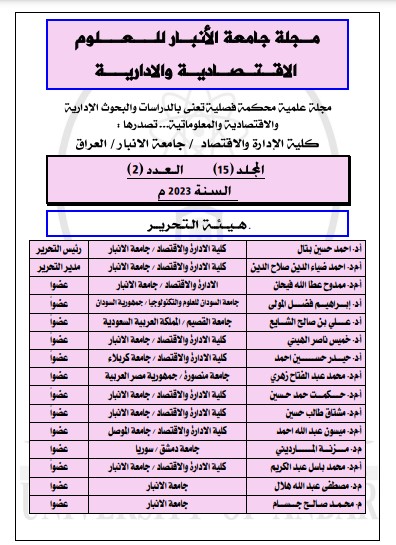نوع المقالة : Research Paper
المؤلفون
كلية الإدارة والاقتصاد / جامعة السليمانية
الملخص
نموذج cox للأنحدار هو واحد من النماذج التي يتم استخدامه بالكثرة في تحليل بيانات للبقاء يستخدم لتحديد العلاقة بين المتغيرات التفسيرية المتوافرة للمفردة المدروسة و وقت البقاء لهم. وان الهدف في هذه الدراسة هي تحليل مدة بقاء لمرض المصابين بسرطان الدم (اللوكيميا) بأستخدام النموذجين إحصائين (نموذج انحدار كوكس ونموذج المخاطر المتنافسة). ان البيانات المستخدم في هذه الدراسة هي بيانات المراقبة من نوع الأول والتي تم أخذها من مستشفى نانكلي-اربيل ل(120) من المرض المصابين بسرطان الدم خلال (أربعة سنة) يبدأ من ( 1 يناير 2019) الى (30 مايو 2022). ويتم استخدام معيار المعلومات اكاكي Akaike (AIC), معيار معلومات Akaike المصحح (AICc) و معيار المعلومات بيز Bayesian (BIC) لكل نموذج لمقارنة بين نموذجين أي نموذج من النموذجين يلائم البيانات. ومن خلال تحليل البيانات البقاء يبين أن النموذج المخاطر المتنافسة يناسب مع البينات وان العامل (نوع العلاج) والعامل (فقر الدم) هما الأكثر خطورة على مرض اللوكيميا.
الكلمات الرئيسة
- Abderrahim Oulhaj et al., 2020.The competing risk between in-hospital mortality and recovery: A pitfall in COVID-19 survival analysis research. Institute of Public Health, College of Medicine and Health Sciences, United Arab Emirates University, Al Ain, United Arab Emirates.
- Alhasawi, E., 2015. Survival Analysis Approaches for Prostate Cancer. Sudbury, Ontario, Canada: Laurentian University.
- Balakrishnan, N. & RAO, C. R., 2004. Handbook of Statistics 23_ Advances in Survival Analysis. north holand: s.n.
- Biost, A. (2004). Introduction to Survival Analysis. new yourk: A Stata Press Publication.
- Bsrat Tesfay et al., 2021. Survival analysis of Time to Death of Breast Cancer Patients: in case of Ayder Comprehensive Specialized Hospital Tigray, Ethiopia. Corresponding author: Endeshaw Assefa Derso, College of Natural and Computational Science, Department of Statistics, University of Gondar, Ethiopia.
- Burnham, Kenneth P. and David R. Anderson. 1998. Model Selection and Inference: A Practical Information-Theoretical Approach. New York: Springer-Verlag.
- Stihsen et al., 2017. The outcome of the surgical treatment of pelvic chondrosarcomas: a competing risk analysis of 58 tumors from a single center, Medical University of Vienna, Vienna, Austria.
- Ekman, A., 2017. Variable selection for the Cox proportional hazards model. Umea university, 21 January.p. 84.
- Fox, John, 2014. Introduction to Survival analysis. sociology 761.
- Frank Emmert-Streib and Matthias Dehmer. 2019. Predictive Society and Data Analytics Lab, Faculty of Information Technology and Communication Sciences, Tampere University, FI-33101 Tampere, Finland
- Guo, S., 2010. Survival analysis. 1st ed. New York: Oxford university press, Inc.
- Harrell, F. E., 2001. Regression Modeling with Applications to Linear Models, Logistic Regression, and Survival Analysis. Nashville, TN 37232-2637: Springer Science+Business Media New York.
- Heagerty, P., 2005. Survival Analysis. new work: Va/Uw Summer.
- Hout, A. V. D., 2017. multi-state survival models for interval censored data. U.S.: taylor & francis group.
- Mark, s., 2007. An Introduction to Survival Analysis. EpiCentre, IVABS, pp. 2-31.
- Liu, x., 2012. Survival analysis 'models and applications'. 1st ed. United Kingdom: John Wiley & Sons Ltd.
- Michele Provenzano et al., 2018. Competing-Risk Analysis of Death and End Stage Kidney Disease by Hyperkaliemia Status in Non-Dialysis Chronic Kidney Disease Patients Receiving Stable Nephrology Care. Journal of Clinical Medicine.
- Qi, J. (2009). Comparison of Proportional Hazards and Accelerated Failure Time Models. Saskatchewan, 1-89.
- Schmidt, P. & WITTE, A. D., 1998. Predicting Recidivism Using Survival Models. 1st ed. London: Springer verlag.
- Vittinghoff, E. 2004. Statistics for Biology Health, Second edition. Science+Business Media, New York.
- Wolbers, marcel, et al., 2009. Prognostic models with competing risks: methods and application to coronary risk prediction. Epidemiology 20.4 (555-561).
- Wienke, A., 2011. Frailty models in survival analysis. 1st ed. USA: Taylor & Francis group, LLC.
- Xin, x., 2011. A STUDY OF TIES AND TIME-VARYING COVARIATES IN COX PROPORTIONAL HAZARDS MODEL. University of Guelph, pp. 1-43.
- Zhou, Bingquing et al., 2011. “Competing risks regression for stratified data”. Biometrics (661-670).

